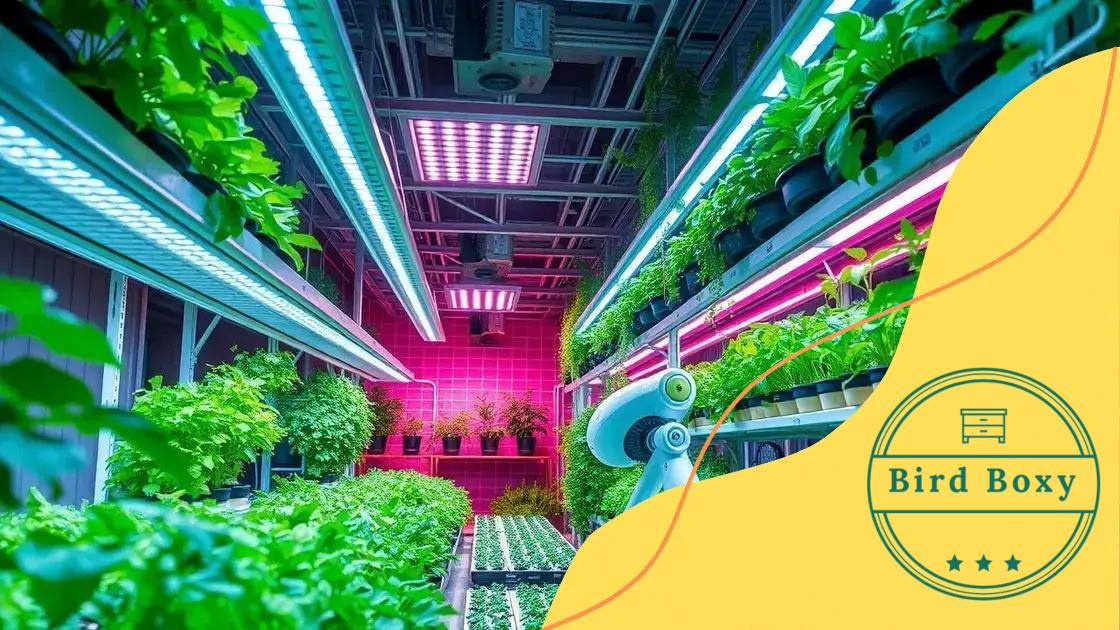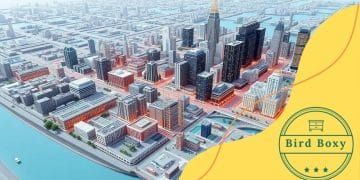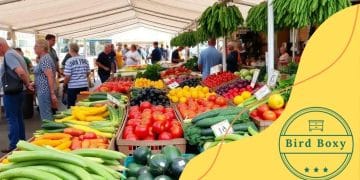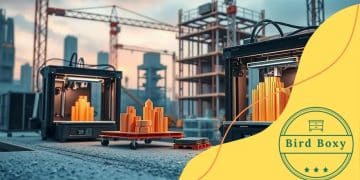Vertical farming urban expansion: the future of food

Vertical farming urban expansion utilizes advanced technology to create sustainable food production systems in cities, addressing space limitations and enhancing food security through innovative practices like hydroponics and community involvement.
Vertical farming urban expansion is reshaping how we think about food production in cities. Have you ever imagined growing fresh herbs and veggies right next door? This innovative approach not only saves space but also promotes sustainability.
Understanding vertical farming and its benefits
Understanding vertical farming is crucial as we move toward sustainable urban agriculture. This innovative method allows us to grow food in stacked layers, maximizing space and resources in urban areas. By utilizing controlled environments, vertical farms can produce fresh produce year-round, regardless of the outdoor climate.
Benefits of Vertical Farming
The benefits of vertical farming extend beyond mere space-saving. It not only reduces the carbon footprint associated with transporting food but also increases accessibility to fresh produce in urban settings. Here are some key advantages:
- Water Conservation: Vertical farms use up to 90% less water compared to traditional farming methods.
- Pesticide Reduction: The controlled environment minimizes the need for harmful pesticides, resulting in healthier crops.
- Higher Crop Yields: Multiple layers of crops lead to increased production per square foot, enhancing food security.
- Community Engagement: These farms can create local jobs and involve communities in sustainable practices.
In addition to these benefits, vertical farms contribute to the reduction of transportation costs. When food is grown closer to urban consumers, it means less fuel used in delivery. This not only keeps the produce fresher but also leads to a lower overall environmental impact.
Another important aspect of vertical farming is its ability to adapt to different urban settings. For example, rooftops and abandoned buildings can be repurposed into productive farms. This versatility allows cities to use otherwise wasted spaces for food production, promoting greener urban areas.
Technology in Vertical Farming
Advanced technology plays a pivotal role in the success of vertical farms. Automation, sensors, and data analytics help monitor and optimize growing conditions. As technology progresses, we can expect even greater efficiency and sustainability in urban agriculture.
Overall, the understanding of vertical farming practices and their numerous benefits highlights a significant shift in how we approach food production in cities. With the right support and innovations, these farms could reshape our food systems for the better.
The impact of urban expansion on agriculture
The impact of urban expansion on agriculture is significant as cities grow. With increasing populations, cities need more housing, infrastructure, and services. This growth often leads to less available land for traditional farming. As a result, farmers face challenges in producing enough food for urban dwellers.
Reduction of Arable Land
As cities expand, prime agricultural land is converted into residential and commercial properties. This reduction of arable land can severely affect local food production. Urban areas may also face food deserts, where access to fresh produce becomes limited. This situation highlights the need for innovative agricultural practices within cities.
- Soil Degradation: Urban development can lead to soil erosion and degradation, making it harder to grow crops.
- Water Supply Issues: Increased demand for water in urban settings can strain resources essential for agriculture.
- Loss of Biodiversity: Expanding cities can disrupt local ecosystems, leading to a decline in plant and animal species.
- Increased Transportation Costs: With agriculture pushed further from city centers, transporting food becomes costlier and less efficient.
Moreover, the need for food sustainability becomes even more critical. Urban expansion prompts a rising interest in methods such as vertical farming and community gardens to reclaim and utilize available space effectively. These practices help mitigate the loss of traditional farmland and enhance local food security.
While urban growth poses challenges, it also opens opportunities to reimagine food production. For instance, integrating farms within urban settings can create vibrant food hubs, fostering community involvement and education on sustainability.
Understanding the relationship between urban expansion and agriculture is essential for developing strategies that promote food resilience. As cities continue to grow, innovative approaches will be vital in ensuring that urban populations have access to fresh, nutritious food.
Technological innovations in vertical farming

Technological innovations in vertical farming are driving the future of urban agriculture. These advancements are essential for maximizing crop yield while minimizing resource use. Innovations allow us to grow food more efficiently, making it possible for cities to feed their growing populations.
Hydroponics and Aeroponics
One major innovation in vertical farming is the use of hydroponics and aeroponics. These methods enable plants to grow without soil. In hydroponics, plants are grown in nutrient-rich water, while in aeroponics, nutrient mist is sprayed directly onto the roots. Both techniques significantly reduce water usage and increase growth rates.
- Faster Growth: Plants grown using these methods often grow faster than those in soil.
- Space Efficiency: These methods can be used in smaller areas, allowing for multiple layers of crops.
- Pest Control: Without soil, the risk of soil-borne pests decreases, leading to healthier plants.
Another exciting innovation is the use of artificial intelligence (AI) in monitoring and managing crops. AI systems can analyze growth conditions, adjust lighting, and optimize nutrient delivery. Such technologies help farmers respond quickly to changes, ensuring optimal growth.
Lighting technology also plays a vital role. LED lights are now commonly used in vertical farms because they consume less energy and can be tailored to specific plant needs. Different colors and intensities of light can promote faster growth and better yields, making it easier to grow a variety of crops year-round.
Data Analytics and Automation
Data analytics helps farmers make informed decisions based on real-time data about their crops. By collecting and analyzing this data, vertical farms can identify which plants are thriving and which need attention. This proactive approach enhances overall productivity.
Automation technologies, such as robotics, are also becoming more prevalent. Robots can handle tasks like planting, harvesting, and even packaging produce. This results in reduced labor costs and increased efficiency, allowing human workers to focus on more complex tasks.
In summary, the integration of these technological innovations in vertical farming is not only revolutionizing agriculture but also paving the way for sustainable food production in urban environments. As these technologies continue to evolve, they hold great promise for increasing food security and sustainability.
Challenges facing urban vertical farms
Challenges facing urban vertical farms are significant, even with their many advantages. As cities embrace this innovative form of agriculture, several hurdles remain that need addressing. These challenges can impact the viability and success of vertical farming initiatives.
High Initial Costs
One major challenge is the high initial investment required to set up vertical farms. The cost of technology, equipment, and infrastructure can be quite substantial. Many urban farmers struggle to secure funding to cover these expenses, which can hinder the growth of new farms.
- Technological Investment: The need for advanced systems such as hydroponics, LED lighting, and climate control adds to the startup costs.
- Infrastructure Requirements: Renovating existing buildings or constructing new ones to accommodate vertical farming can be expensive.
- Operational Costs: High utility costs for energy and water usage can impact profitability.
Another challenge is the regulatory environment. Urban vertical farms often face complex zoning laws and regulations that can complicate operations. Navigating these regulations can be time-consuming and requires expertise, which some urban farmers may lack.
The competition for space in urban areas also poses a challenge. As cities grow, land becomes more valuable and scarce. Urban farms must compete with residential and commercial developments for prime locations. This competition can limit where vertical farms are established and decrease accessibility to essential urban resources.
Knowledge Gaps and Expertise
Knowledge gaps in managing vertical farms can hinder their success. Farmers must understand advanced agricultural practices and technologies to operate effectively. Many traditional farmers may not possess the necessary skills to transition into this new method of farming.
Even with the right technology, vertical farms are still vulnerable to economic factors. Changes in consumer demand and market prices can affect their sustainability. Urban farms rely on buying local produce and consumers being willing to pay premium prices for fresh, locally grown foods. Fluctuating trends in food consumption can significantly impact profitability.
Despite these challenges, urban vertical farms continue to adapt and find solutions to thrive. Through innovation and collaboration, these farms can overcome obstacles, improving food access in urban areas and contributing to sustainability.
Future trends in sustainable urban farming
Future trends in sustainable urban farming point toward innovative and eco-friendly practices that will reshape how cities produce food. As the world grapples with challenges like climate change and urbanization, these trends are essential for ensuring food security.
Increased Use of Technology
One significant trend is the increased use of technology in farming practices. This includes the rise of smart farming solutions, where sensors and IoT devices monitor plant health and environmental conditions. By using real-time data, farmers can optimize their operations to improve yield and reduce waste.
- Data-Driven Decisions: Farmers can make more informed decisions based on analytics, helping to predict crop performance and market demands.
- Remote Monitoring: Technology will enable farmers to manage their crops remotely, ensuring better efficiency.
- Automated Systems: Robotic systems will assist in planting, watering, and harvesting crops, reducing labor costs and improving precision.
Another trend is the integration of sustainable practices into urban agriculture. This includes using renewable energy sources like solar and wind power to operate farms. As a result, farms will have lower operational costs and a smaller carbon footprint.
Community Involvement and Education
Community involvement will also play a key role in the future of urban farming. More cities are encouraging local participation through community gardens and educational programs. These initiatives help raise awareness about the importance of sustainable practices.
By fostering a sense of community around farming, cities can inspire residents to take an active role in food production. This engagement helps build relationships and encourages healthier eating habits among city dwellers.
Furthermore, vertical farms and rooftop gardens are expected to gain popularity. These methods maximize space usage in cities and provide fresh produce directly to local consumers. With the growing interest in local food systems, these urban farming strategies will likely become more widespread.
Collaboration with Local Governments
Finally, collaboration between urban farms and local governments is crucial for the future of sustainable urban farming. Incentives and support from city officials can help alleviate some challenges farmers face, like zoning issues and access to resources.
As urban areas evolve, establishing policies that support sustainable farming practices will be vital. By prioritizing sustainable urban farming, cities can create a more resilient and self-sufficient food system.
FAQ – Frequently Asked Questions about Urban Vertical Farming
What are the main benefits of urban vertical farming?
Urban vertical farming offers benefits such as reduced transportation costs, year-round crop production, and efficient land use, supporting local food security.
How does technology enhance vertical farming?
Technology improves vertical farming by using smart sensors, automated systems, and data analytics to monitor and optimize growing conditions.
What challenges do urban vertical farms face?
Urban vertical farms often encounter challenges like high startup costs, regulatory hurdles, and competition for space in rapidly growing urban areas.
How can communities get involved in urban farming?
Communities can get involved through initiatives like community gardens, workshops, and partnerships with local farms to promote urban agriculture and sustainability.






